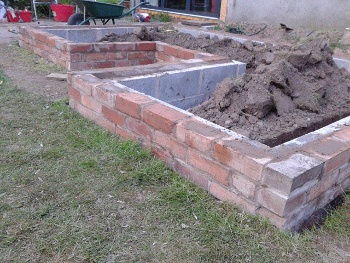Our renovation project is getting us to do things neither of us have ever done before. This week, we’re trying our hand at brick laying. Here are some things I never knew.
1. Like many DIY jobs, mixing mortar is a bit like making cake. You have to get the right consistency: moist but doesn’t stick to your hands.
2. A good proportion is 1 part cement to 3 parts sand. It’s a good idea to mix one part of cement with one part of sand dry in a bucket before you start the cement mixer. The hardest part is to get the stuff to mix properly in the mixer.
3. Just like cake, the amount of water needed depends on the kind of sand and cement you’ve got. The moister the sand, the less water you’ll need.
4. Start with some water in the drum. Then add a couple of spade fulls of sand. Add the sand-cement mix last. This will quickly change the nature of your mix.
5. Aim the sand and cement at the watery mix. If you get it on the dry part of the drum, it’ll just stick there and not get mixed in. Then you need to stop the drum and push it all around with your hands.
6. Keep adding sand and cement. When the mix gets too dry, it will look like small lumps rattling around in the drum. Add a bit more water.
7. You’ve got it more or less right when the mortar becomes one big mass that falls down from the top of the drum as it goes round. A smooth lump sloughing down is what you’re looking for. Now is the time to stop the drum and do a hand test. It needs to be moist but leave your hand virtually clean.
8. Life is a lot easier when your bricks are wet. Put one in a bucket of water while you’re mortaring in the previous one. It’ll help your mortar stick to the brick and will save you a lot of trouble.
9. If you are using reclaimed bricks, make sure they are clean. Any dirt left on them will prevent them from absorbing the mortar and sticking together.
10. If you are a beginner, you’re bound to make a mess on the face of your brickwork. If it is going to be on show, it’s a good idea to remove the excess mortar with a scouring pad at the end of the day.
Good luck! And let us know how you get on.


You forgot the last step: don’t forget to wash out the cement mixer before the cement in it sets! Don’t ask me how I know this…
You are so very, very right, Asher